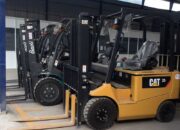Frequently Asked Questions about Kalmar Container Reach Stackers
1. What is the maximum lifting capacity of a Kalmar Reach stacker?
A Kalmar Reach stacker has a maximum lifting capacity ranging from 45 to 50 tons, depending on the specific model. For example, the DRG450-65S5X model can lift up to 45 tons in the first row, while some higher-end models like the DRG500-75S5X can lift up to 50 tons.
2. is the average lifespan of a Kalmar Container Reach stacker?
With proper maintenance, a Kalmar Container Reach stacker can operate efficiently for around 15-20 years. However, the exact lifespan depends on various factors such as usage frequency, working conditions, and maintenance quality. Some of our customers have reported that their machines are still running well after more than 25 years of use.
3. How much is the annual maintenance cost for a Kalmar Reach stacker?
The annual maintenance cost for a Kalmar Reach stacker typically ranges from 3% to 5% of the initial value of the machine. This means that for a machine priced at around $500,000, the annual maintenance cost could be between $15,000 and $25,000. However, this figure may vary depending on usage intensity and operating conditions.
4. What are some special safety features of Kalmar Reach stackers?
Kalmar Reach stackers are equipped with advanced safety features including:
– Anti-Tipping System
– Load weight sensors and overload warning
– 360-degree cameras for comprehensive visibility
– Regenerative braking system
– ROPS (Roll-Over Protective Structure) compliant cabin design
– Obstacle detection and warning system
– Safety lockout system when operator is absent
5. What is the average fuel consumption of a Kalmar Reach stacker?
The average fuel consumption of a Kalmar Reach stacker typically ranges from 12 to 18 liters of diesel per hour of operation, depending on the model and working conditions. Our latest models come with fuel-saving Eco Drive Mode technology that can reduce consumption to as low as 10-15 liters per hour under normal operating conditions.
6. Which Kalmar Reach stacker models are suitable for small and medium-sized ports?
Kalmar offers several Reach stacker models suitable for small and medium-sized ports:
– DRG420-60S5: This model can lift 42 tons, suitable for ports with moderate container traffic.
– DRG450-65S5: With a lifting capacity of 45 tons, this is a flexible choice for various types of ports.
– Gloria DRG100-54S6: This compact model is ideal for ports with limited space.
These models have smaller dimensions, lower fuel consumption, but still ensure high performance.
7. How to optimize the performance of a Kalmar Reach stacker in a port environment?
To optimize performance, it is important to:
– Provide thorough training for operators on efficient driving techniques and stacking operations.
– Use Kalmar’s fleet management software to monitor and analyze performance.
– Implement preventive maintenance to minimize downtime.
– Optimize traffic flow and workspace layout within the port.
– Use Eco Drive mode whenever possible to save fuel.
– Update software regularly to take advantage of the latest improvements.
8. What are the key advantages of Kalmar Reach stackers compared to other brands?
Kalmar Reach stackers stand out with:
– Stable operation, high reliability and long lifespan.
– Advanced technology such as SmartWheel intelligent control system.
– Low fuel consumption thanks to Eco Drive technology.
– Ergonomic cabin design with good visibility for operator comfort.
– Global support network and service offerings from the brand.
– Many integration options with automation systems in warehouses and ports.
9. How long does training for operating a Kalmar Reach stacker typically last?
Training usually lasts from 2 to 4 weeks including:
– One week theoretical training on safety, operational mechanisms and basic maintenance.
– One-two weeks practical training on simulator machines.
– One week practical training on real machines under supervision.
After training completion, operators need an additional 100–200 hours of practice to become proficient. Kalmar also provides advanced training courses and regular updates.
10. How to troubleshoot common issues on a Kalmar Reach stacker?
Common troubleshooting steps for issues on a Kalmar Container reach Stacker include:
– Use onboard diagnostic systems to identify faults.
– Refer to user manuals for basic troubleshooting procedures.
– For engine issues check fuel levels, air filters and electrical connections.
– For hydraulic issues check oil levels and leaks.
– For electrical issues check fuses and connections.
11. What automation features are available on the latest models of Kalmar Reach Stackers?
The latest models of Kalmar reach Stackers come equipped with advanced automation features such as:
– Auto-positioning system for automatic container positioning
– Auto-leveling system for automatic load balancing
– Automatic collision avoidance system
– Auto-steering mode along predefined paths
– Automatic diagnostic feature reporting errors







